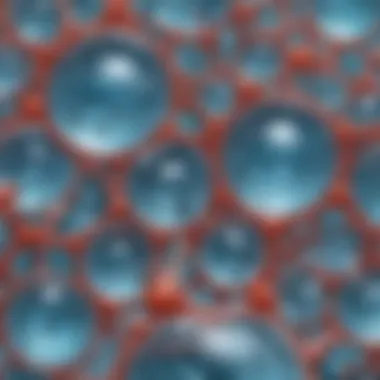Unveiling the Intricacies of Water's Scientific Realm


Science Fun Facts
Did you know that water is the only substance that naturally exists in all three states – liquid, solid, and gas – within Earth's normal temperature range and at atmospheric pressure? This remarkable ability is due to its unique molecular structure. Water molecules are attracted to each other, forming a 'water network' that allows for easy transformation between states.
Discover the Wonders of Science
By exploring various scientific concepts related to water, we can uncover its essential role in sustaining life on Earth. Educational videos and animations can visually demonstrate concepts like the water cycle, cohesion, and adhesion. Interactive learning tools make comprehension engaging and fun for learners of all ages. Real-life applications of scientific knowledge about water range from agricultural practices to environmental sustainability.
Science Quiz Time
Engage in interactive quizzes to test your understanding of water's properties and behaviors. These quizzes include multiple-choice questions that challenge critical thinking skills. Brain teasers and puzzles centered around water science can provide an entertaining yet educational experience. Learning through gamification makes the exploration of water concepts enjoyable and memorable.
Science Experiment Showcase
Embark on fun and engaging experiments that showcase the unique properties of water. Step-by-step instructions guide you through activities that highlight concepts like surface tension, density, and capillary action. The materials list includes everyday items easily accessible at home. Safety tips and precautions ensure a secure and educational hands-on experience with water experiments.
Introduction to Water
Water, the ubiquitous and essential compound that sustains life on our planet, is at the heart of scientific inquiry and exploration. This section serves as a gateway to unraveling the mysteries of this fascinating liquid. With a focus on its chemical composition and physical properties, we embark on a journey to understand the very essence of water, from its fundamental structure to its remarkable behavior. By shedding light on the intricate nature of water, we lay the foundation for a comprehensive examination of its significance across various scientific disciplines.
Chemical Composition of Water
Structure of a Water Molecule
The structure of a water molecule, comprising two hydrogen atoms covalently bonded to a single oxygen atom, plays a fundamental role in defining the unique properties of water. This molecular arrangement leads to a bent shape, with oxygen exhibiting a partial negative charge and hydrogen a partial positive charge. These polar characteristics enable water molecules to form hydrogen bonds, which facilitate cohesion, adhesion, and surface tension. The significance of this structure lies in its ability to ensure water's versatility as a solvent, enabling crucial biological processes and environmental interactions.
Hydrogen Bonds in Water


Hydrogen bonds, the intermolecular forces between water molecules, are paramount in dictating many of water's properties. These weak attractions allow water to exhibit high surface tension, resist temperature changes, and possess a relatively high specific heat capacity. The cohesive nature of hydrogen bonds also contributes to water's role as an excellent solvent. Despite being weaker than covalent or ionic bonds, hydrogen bonds are crucial for maintaining the integrity of biological macromolecules and sustaining life processes. Their presence influences biological structures, from DNA double helix stability to protein folding mechanisms.
Physical Properties of Water
Density and Specific Heat
The density of water, at its maximum at 4°C, varies with temperature changes, displaying a unique behavior compared to most liquids. This exceptional characteristic contributes to the role of water as a vital medium for various biological processes and climatic phenomena. Additionally, water's high specific heat capacity allows it to absorb and store large amounts of thermal energy without significant temperature changes. Hence, water serves as a natural thermostat, regulating climates and supporting aquatic life.
Surface Tension and Capillary Action
Surface tension, a result of cohesive forces between water molecules at the liquid-air interface, enables water to form droplets, exhibit meniscus formation, and support insects on its surface. Capillary action, driven by intermolecular forces and adhesion properties, allows water to defy gravity and climb upwards thin tubes. These properties manifest in phenomena like water transport in plants, ink drawing in pens, and blood circulation in living organisms.
The Role of Water in Nature
Water, the ubiquitous molecule that sustains life on our planet, plays a crucial role in the natural world, influencing ecosystems, climate patterns, and geological processes. Its presence shapes landscapes, drives weather systems, and enables the diverse forms of life we observe. Understanding the dynamics of water in nature is paramount to comprehending the intricate web of interconnected systems that support life. From nourishing plant life to regulating temperatures, water serves as a cornerstone of the natural world.
Water in the Environment
Water Cycle and Its Significance
The Water Cycle, a fundamental process in the Earth's hydrological system, showcases the continuous movement of water between the atmosphere, land, and oceans. Its significance lies in regulating global climate patterns, replenishing freshwater sources, and supporting various life forms. This cyclic journey of precipitation, evaporation, and condensation sustains ecosystems, shaping environments and influencing biodiversity. The efficiency and resilience of the Water Cycle are crucial for maintaining environmental balance and ensuring the availability of clean water for all living organisms.
Impact of Water on Ecosystems
Water is a cornerstone of ecosystems, influencing the distribution, composition, and dynamics of biological communities. Its presence fosters habitats for a myriad of species, creating niches for aquatic life and sustaining terrestrial flora and fauna. The Impact of Water on Ecosystems extends beyond local environments, influencing global biodiversity and ecological resilience. From freshwater ecosystems to marine biomes, water plays a pivotal role in shaping ecosystems and facilitating the intricate web of interactions among organisms.
Water in Living Organisms
Importance of Water in Biological Processes


Water's significance in biological processes is unparalleled, serving as a universal solvent, medium for chemical reactions, and regulator of temperature. Its unique properties, such as cohesion and high specific heat, enable metabolic processes, nutrient transport, and waste removal in organisms. Water's role in maintaining cellular functions and supporting biochemical reactions underscores its indispensable nature in the realm of life.
Role of Water in Cells and Metabolism
Within living organisms, water plays a fundamental role in cellular structures, metabolic pathways, and energy production. It provides a medium for biochemical reactions, facilitates nutrient uptake, and aids in the elimination of metabolic byproducts. The Role of Water in Cells and Metabolism influences cell shape, osmotic balance, and biochemical signaling, highlighting its essentiality for the proper functioning of biological systems. Through its pervasive presence and dynamic interactions, water sustains life at the molecular level, driving the myriad processes essential for organismal survival.
Water in Different Scientific Disciplines
Water plays a pivotal role across various scientific disciplines, showcasing its versatility and significance in each domain. In the realm of chemistry, water's solvent properties are fundamental to numerous reactions and processes. Its ability to dissolve a wide range of substances is crucial for biochemical reactions and essential for sustaining life. Furthermore, the unique characteristics of water, such as its high polarity and cohesive nature, make it an invaluable solvent for a multitude of chemical reactions, both in laboratories and in natural environments.
Water in Chemistry
Solvent Properties of Water
Water's solvent properties are indispensable for dissolving and transporting various molecules in biological systems and chemical reactions. The polarity of water molecules allows them to interact with solutes, facilitating the dissociation and recombination of substances. This property enables the manifestation of acid-base reactions and the formation of solution phases crucial for numerous biochemical processes. The cohesive forces between water molecules create a stable environment for chemical interactions to occur with precision and efficiency, highlighting the solvent's crucial role in maintaining homeostasis within living organisms.
Acid-Base Reactions in Water
Acid-base reactions in water exemplify the importance of this universal solvent in mediating essential chemical processes. The self-ionization of water leads to the generation of hydronium and hydroxide ions, establishing a dynamic equilibrium that influences pH levels and catalyzes chemical reactions. This key characteristic of water enables it to act as a buffer, regulating the acidity or alkalinity of solutions and maintaining stability in diverse environments. Understanding acid-base reactions in water provides insights into biological systems and environmental chemistry, offering a foundational knowledge base for various scientific investigations.
Water in Physics
Hydrodynamics and Fluid Mechanics
Water's significance in physics is exemplified through its role in hydrodynamics and fluid mechanics. The fluidity and density of water make it an ideal medium for studying the principles of fluid dynamics, including flow velocity, turbulence, and viscosity. Hydrodynamics explores the behavior of fluids in motion, showcasing water's ability to exhibit complex dynamics in channels and vessels. Understanding fluid mechanics aids in analyzing hydraulic systems, weather patterns, and oceanic currents, underscoring the essential nature of water in shaping physical phenomena.
Water's Role in Thermodynamics
The role of water in thermodynamics is paramount, particularly in heat transfer and energy conversion processes. Water's high specific heat capacity and thermal conductivity make it an efficient medium for storing and distributing thermal energy. Its phase transitions, such as evaporation and condensation, play a crucial role in weather patterns and climate regulation. Additionally, water's ability to absorb and release heat influences Earth's temperature gradients, impacting environmental dynamics and global circulation patterns. Examining water's role in thermodynamics unveils intricate connections between heat transfer mechanisms and natural phenomena, illustrating the interconnectedness of physical processes.


Water in Biology
Importance of Water in Photosynthesis
Water's importance in photosynthesis stems from its role as a reactant in the light-dependent reactions of plants. By participating in the electron transport chain and oxygen-evolving complex, water molecules contribute to the production of oxygen and energy-rich molecules essential for plant growth. The unique ability of water to undergo photolysis and release electrons is pivotal for sustaining photosynthetic activity, driving carbon fixation and biomass production. Understanding the significance of water in photosynthesis elucidates the intricate biochemical pathways that support plant metabolism and ecosystem productivity.
Role of Water in Genetic Material
Water serves as a crucial component in the conformation and stability of genetic material, influencing the structure and function of nucleic acids. The hydrogen bonds between water molecules and DNA/RNA strands maintain the double helix structure, ensuring genetic integrity and replication fidelity. Water's interactions with genomic material facilitate DNA replication, transcription, and translation, orchestrating cellular processes essential for maintaining organismal vitality. Recognizing the role of water in genetic material sheds light on the complexity of molecular interactions and the profound impact of hydration on biological macromolecules.
Emerging Trends in Water Research
In the ever-evolving landscape of scientific inquiry, the domain of water research stands out as a critical arena for exploration and innovation. As the world grapples with escalating water scarcity and pollution challenges, the emergence of new trends in water research takes on paramount importance. This section delves into the cutting-edge developments that are shaping the future of water science.
Nanotechnology and Water Purification
Applications of Nanomaterials in Water Treatment
While traditional water treatment methods have been effective to a certain extent, the integration of nanotechnology into water purification processes has revolutionized the field. Nanomaterials, with their microscopic size and high surface area-to-volume ratio, exhibit exceptional adsorption properties, enhancing the removal of contaminants from water sources. This unique characteristic makes nanomaterials a promising choice for addressing complex water quality issues, such as the elimination of emerging pollutants and heavy metals. Despite their efficacy, the use of nanomaterials raises concerns regarding their long-term environmental impacts and potential health risks.
Advancements in Water Desalination Technologies
The advancements in water desalination technologies mark a significant leap forward in ensuring access to clean water resources, particularly in arid regions facing freshwater scarcity. Innovative desalination techniques, such as reverse osmosis and multi-stage flash distillation, have significantly improved the efficiency and sustainability of desalination processes. The key characteristic of these advancements lies in their ability to produce high-quality drinking water from brackish or seawater sources, thereby mitigating water stress challenges in water-stressed regions. However, the energy-intensive nature of desalination technologies poses environmental concerns related to carbon emissions and energy consumption.
Sustainable Water Management
In the face of escalating water demand and dwindling freshwater reserves, the concept of sustainable water management takes center stage as a holistic approach to conserving and managing water resources effectively. This section explores innovative strategies that promote the responsible use of water while minimizing wastage and environmental impact.
Water Conservation Strategies
Water conservation strategies play a crucial role in optimizing water use efficiency and reducing water loss in various sectors, ranging from agriculture to urban municipalities. By implementing measures such as rainwater harvesting, xeriscaping, and leak detection programs, significant water savings can be achieved. The key characteristic of water conservation strategies lies in their ability to reduce overall water demand, leading to long-term water security and sustainability. Despite their benefits, these strategies require continual monitoring and community involvement to ensure their successful implementation.
Innovative Approaches to Water Recycling
As the global population burgeons and water resources come under increasing pressure, innovative approaches to water recycling offer a sustainable solution to augment water supply. Technologies like greywater recycling and advanced treatment processes enable the safe reuse of wastewater for non-potable purposes, conserving freshwater resources and minimizing wastewater discharge. The unique feature of water recycling lies in its potential to create a closed-loop water system, reducing reliance on freshwater sources and alleviating strain on natural ecosystems. However, challenges related to public acceptance and infrastructure limitations pose hurdles to widespread adoption of water recycling practices.







